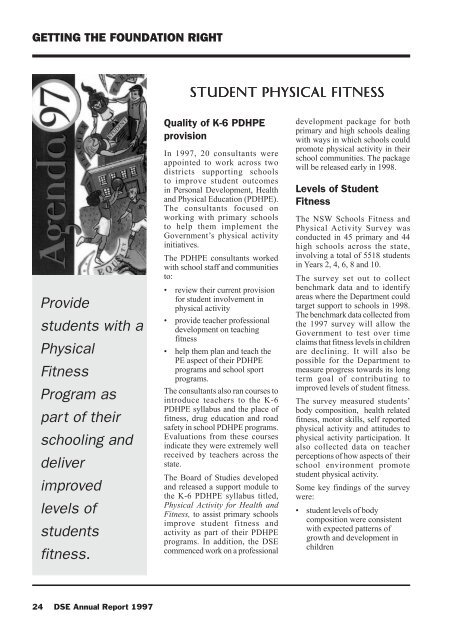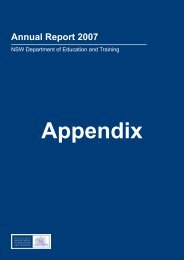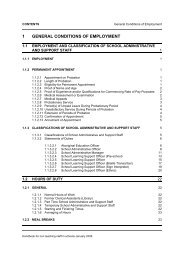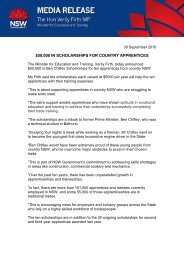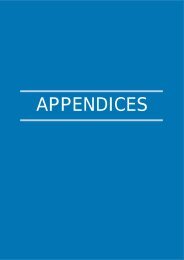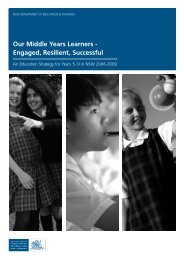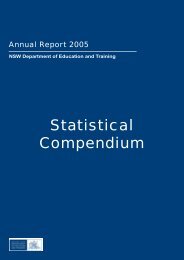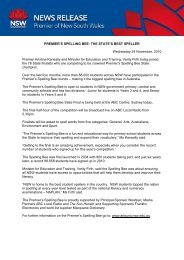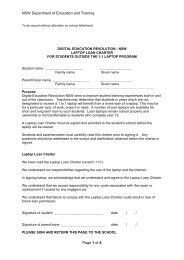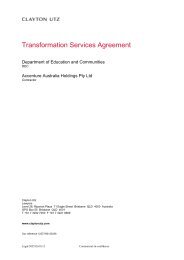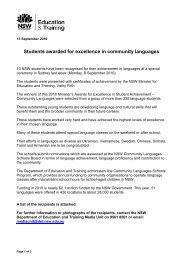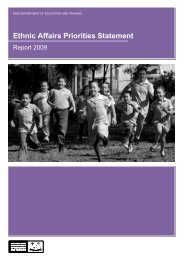01 - Department of Education and Communities - NSW Government
01 - Department of Education and Communities - NSW Government
01 - Department of Education and Communities - NSW Government
You also want an ePaper? Increase the reach of your titles
YUMPU automatically turns print PDFs into web optimized ePapers that Google loves.
GETTING THE FOUNDATION RIGHTSTUDENT PHYSICAL FITNESSProvidestudents with aPhysicalFitnessProgram aspart <strong>of</strong> theirschooling <strong>and</strong>deliverimprovedlevels <strong>of</strong>studentsfitness.Quality <strong>of</strong> K-6 PDHPEprovisionIn 1997, 20 consultants wereappointed to work across twodistricts supporting schoolsto improve student outcomesin Personal Development, Health<strong>and</strong> Physical <strong>Education</strong> (PDHPE).The consultants focused onworking with primary schoolsto help them implement the<strong>Government</strong>’s physical activityinitiatives.The PDHPE consultants workedwith school staff <strong>and</strong> communitiesto:• review their current provisionfor student involvement inphysical activity• provide teacher pr<strong>of</strong>essionaldevelopment on teachingfitness• help them plan <strong>and</strong> teach thePE aspect <strong>of</strong> their PDHPEprograms <strong>and</strong> school sportprograms.The consultants also ran courses tointroduce teachers to the K-6PDHPE syllabus <strong>and</strong> the place <strong>of</strong>fitness, drug education <strong>and</strong> roadsafety in school PDHPE programs.Evaluations from these coursesindicate they were extremely wellreceived by teachers across thestate.The Board <strong>of</strong> Studies developed<strong>and</strong> released a support module tothe K-6 PDHPE syllabus titled,Physical Activity for Health <strong>and</strong>Fitness, to assist primary schoolsimprove student fitness <strong>and</strong>activity as part <strong>of</strong> their PDHPEprograms. In addition, the DSEcommenced work on a pr<strong>of</strong>essionaldevelopment package for bothprimary <strong>and</strong> high schools dealingwith ways in which schools couldpromote physical activity in theirschool communities. The packagewill be released early in 1998.Levels <strong>of</strong> StudentFitnessThe <strong>NSW</strong> Schools Fitness <strong>and</strong>Physical Activity Survey wasconducted in 45 primary <strong>and</strong> 44high schools across the state,involving a total <strong>of</strong> 5518 studentsin Years 2, 4, 6, 8 <strong>and</strong> 10.The survey set out to collectbenchmark data <strong>and</strong> to identifyareas where the <strong>Department</strong> couldtarget support to schools in 1998.The benchmark data collected fromthe 1997 survey will allow the<strong>Government</strong> to test over timeclaims that fitness levels in childrenare declining. It will also bepossible for the <strong>Department</strong> tomeasure progress towards its longterm goal <strong>of</strong> contributing toimproved levels <strong>of</strong> student fitness.The survey measured students’body composition, health relatedfitness, motor skills, self reportedphysical activity <strong>and</strong> attitudes tophysical activity participation. Italso collected data on teacherperceptions <strong>of</strong> how aspects <strong>of</strong> theirschool environment promotestudent physical activity.Some key findings <strong>of</strong> the surveywere:• student levels <strong>of</strong> bodycomposition were consistentwith expected patterns <strong>of</strong>growth <strong>and</strong> development inchildren24 DSE Annual Report 1997


